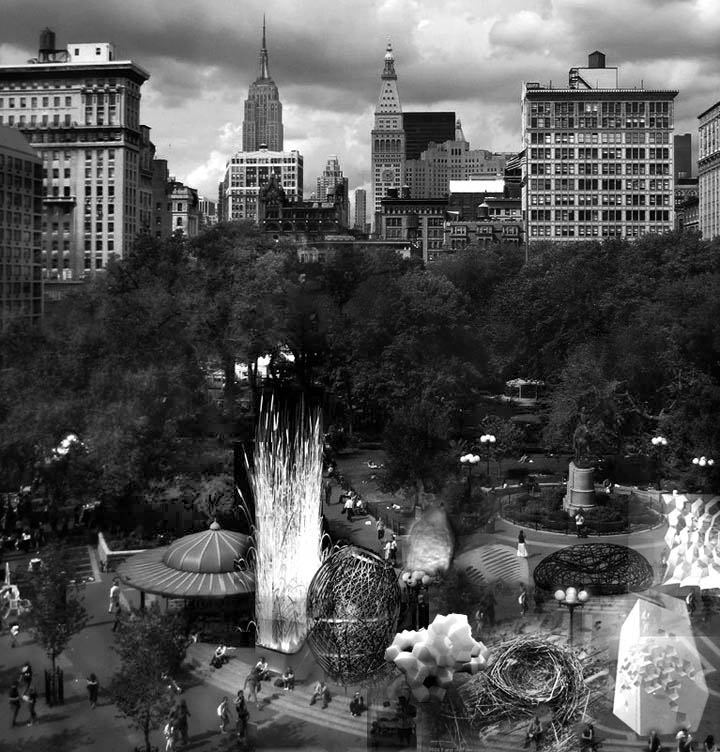 [Image: The original graphic for Sukkah City].
[Image: The original graphic for Sukkah City].All twelve winning designs for the Sukkah City competition have now been posted, along with an article in New York magazine giving an overview of what comes next. The actual construction of each of these temporary buildings is now underway, with all twelve soon to be standing in Manhattan's Union Square.
The competition, as New York suggests, weds "religious tradition with architectural radicalism in the timely form of short-term shelter"—and the built results go up Sunday, September 19, through the evening of Monday, September 20.
 [Image: P.YGROS.C—short for "Passive Hygroscopic Curls," as if Autechre meets the Talmud—by THEVERYMANY of Brooklyn].
[Image: P.YGROS.C—short for "Passive Hygroscopic Curls," as if Autechre meets the Talmud—by THEVERYMANY of Brooklyn].I've included images of just four of those finalists—but, with 600 entries coming in from 43 countries, the full extent of the competition is well worth checking out over at the contest website.
 [Image: Gathering by Dale Suttle, So Sugita, and Ginna Nguyen of New York City].
[Image: Gathering by Dale Suttle, So Sugita, and Ginna Nguyen of New York City].It's also worth recalling the actual design guidelines, which are taken straight from rabbinical interpretations of the original sukkah form and explain many of the formal gestures you see here.
New York points out a few specifics from this "thicket of rules":
- The Talmud demands that a sukkah have at least two and a half walls, a roof that allows indwellers to see the stars and feel the rain but nevertheless stay mostly in the shade. The roof must be made of uprooted organic material—twigs or fronds, say—but no food or utensils (no chopstick thatching allowed). Mystifyingly, the rabbis of yore explicitly permitted the carcass of an elephant to be used as one of the walls. (No contestants took advantage of that option, sensing perhaps that the Department of Buildings or PETA might not concur.)

 [Images: (top) Fractured Bubble by Henry Grosman and Babak Bryan of Long Island City; (bottom) Shim Sukkah by tinder, tinker of Sagle, Idaho].
[Images: (top) Fractured Bubble by Henry Grosman and Babak Bryan of Long Island City; (bottom) Shim Sukkah by tinder, tinker of Sagle, Idaho].Diving into the architectural mythology of the sukkah, de Monchaux shows how the almost whimsically restrictive limits of what constitutes a sukkah open up a hugely various, dynamic, and complex space for contemporary design.
And there are some great designs in there; one of my favorites—which turned out to have been co-designed by one of my former students at Columbia—didn't make the final cut, but seems worth reproducing here: a sukkah held together through a superstructure of rope that then spools back down through the portable foundations of the sukkah itself, like some geometric cross between the terrestrial and the maritime. Where masts are walls, and the floor is the deck of a grounded vessel.
 [Image: XNOT by Morgan Reynolds, Ravi Raj, and John Becker of New York City].
[Image: XNOT by Morgan Reynolds, Ravi Raj, and John Becker of New York City].Regrettably, I will not be in NYC to see the actual installation, but I eagerly await seeing photos and videos of the results. Feel free to leave comments here, or to email me, with images.
And congratulations to the twelve finalists! It was an exciting competition, stimulating a huge range of reactions to almost every single project, and I was thrilled to be part of the judging process.
Finally, vote for the "People's Choice Sukkah" over at New York magazine.
Không có nhận xét nào:
Đăng nhận xét